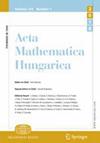典型实奇数多项式的极值问题
IF 0.6
3区 数学
Q3 MATHEMATICS
引用次数: 0
摘要
在阶数为(2N-1\)$$F(z)=z+\sum_{j=2}^Na_jz^{2j-1}$$的典型实奇数多项式类上,我们考虑了两个问题:1)在上述多项式映射下拉伸中心单位圆盘;2)估计系数(a_2.\)。|{F(z)}|le \frac12\csc^2\left({\frac{\pi}{2N+2}}\right),\-1+4\sin^2\left({\frac{\pi}{2N+4}}\right)\le a_2\le-1+4\cos^2\left({\frac{\pi}{N+2}}\right) \quad \text{for odd $N$、}end{gathered} $$and$$-1+4(\nu_N)^2\le a_2\le -1+4\cos^2\left({\frac\pi}{N+2}}\right) \quad \text{对于偶数 $N$、其中 \(\nu_N\) 是方程 \(U'_{N+1}(x) = 0\) 的最小正根,\(U'_{N+1}(x)\) 是相应阶的切比雪夫二阶多项式的导数。上述边界是尖锐的,相应的estremizers是唯一的,系数也是确定的。本文章由计算机程序翻译,如有差异,请以英文原文为准。
Extremal problems for typically real odd polynomials
On the class of typically real odd polynomials of degree \(2N-1\)
$$F(z)=z+\sum_{j=2}^Na_jz^{2j-1}$$
we consider two problems: 1) stretching the central unit disc under the above polynomial mappings and 2) estimating the coefficient \(a_2.\) It is shown that
$$\begin{gathered} |{F(z)}|\le \frac12\csc^2\left({\frac{\pi}{2N+2}}\right),\\-1+4\sin^2\left({\frac{\pi}{2N+4}}\right)\le a_2\le-1+4\cos^2\left({\frac{\pi}{N+2}}\right) \quad \text{for odd $N$,}\end{gathered} $$
and
$$-1+4(\nu_N)^2\le a_2\le -1+4\cos^2\left({\frac{\pi}{N+2}}\right) \quad \text{for even $N$,}$$
where \(\nu_N\) is a minimal positive root of the equation \(U'_{N+1}(x) = 0\) with \(U'_{N + 1}(x)\) being the derivative of the Chebyshev polynomial of the second kind of the corresponding order. The above boundaries are sharp, the corresponding estremizers are unique and the coefficients are determined.
求助全文
通过发布文献求助,成功后即可免费获取论文全文。
去求助
来源期刊
CiteScore
1.50
自引率
11.10%
发文量
77
审稿时长
4-8 weeks
期刊介绍:
Acta Mathematica Hungarica is devoted to publishing research articles of top quality in all areas of pure and applied mathematics as well as in theoretical computer science. The journal is published yearly in three volumes (two issues per volume, in total 6 issues) in both print and electronic formats. Acta Mathematica Hungarica (formerly Acta Mathematica Academiae Scientiarum Hungaricae) was founded in 1950 by the Hungarian Academy of Sciences.

 求助内容:
求助内容: 应助结果提醒方式:
应助结果提醒方式:


